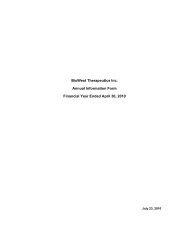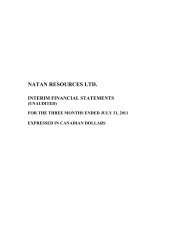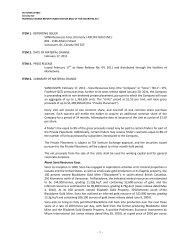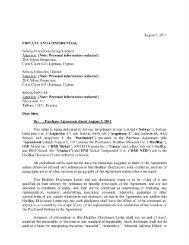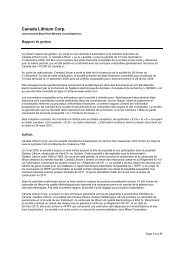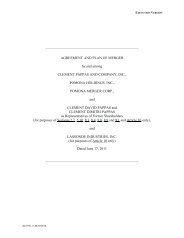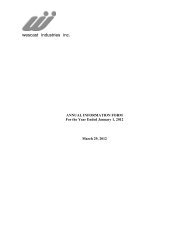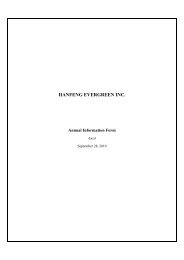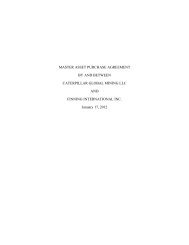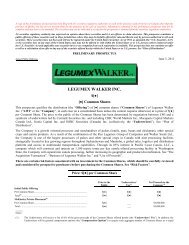ANNUAL INFORMATION FORM – XEBEC ADSORPTION INC. – For ...
ANNUAL INFORMATION FORM – XEBEC ADSORPTION INC. – For ...
ANNUAL INFORMATION FORM – XEBEC ADSORPTION INC. – For ...
You also want an ePaper? Increase the reach of your titles
YUMPU automatically turns print PDFs into web optimized ePapers that Google loves.
which molecules can actually enter the zeolite pore. In this way they act just like a sieve,<br />
therefore their common name - molecular sieve. One important property of adsorbents is their<br />
ability to remove impurities at very low concentrations. This means they can be used to purify a<br />
gas to a very high degree of purification. Certain adsorbents have larger pore sizes and are both<br />
used for removal of bulk quantities of impurities since they have a high loading capacity needed<br />
when impurity concentrations are high.<br />
The purification of a gas implies the removal of a trace impurity or contaminant. The<br />
drying of air can be classified in this category since water molecules, considered as the<br />
contaminant in drying applications, are selectively adsorbed onto an adsorbent material as air<br />
passes over it. The impure moist air passes through the adsorbent material and the purified dry<br />
air is then released. Once the adsorbent material is saturated with water molecules, the adsorbed<br />
water can be released by changing the conditions under which it originally adhered in the first<br />
place. This regenerates the adsorbent so it can be used again. The principles of adsorption are<br />
not limited to the extraction of water, extending too many more types of gas purification. <strong>For</strong><br />
instance, if the appropriate adsorbent material is used and other conditions are favorable, it is<br />
possible to selectively remove the carbon dioxide from air, to separate nitrogen from oxygen, or<br />
to dry any other gas such as natural gas.<br />
Pressure Swing Adsorption (PSA). Pressure swing adsorption is a widely used<br />
technology for the purification of gases. This regeneration process is accomplished by reducing<br />
the pressure. At the moderate pressures found in compressed air systems, such as 100 pounds<br />
per square inch, an adsorbent can support a certain amount of moisture. When that pressure is<br />
dropped to ambient air pressure, the adsorbent can only support a smaller amount of moisture.<br />
By swinging the pressure from high to low, it is possible to adsorb large quantities of moisture at<br />
the higher pressure, and then release that moisture at the low pressure. This technique is called<br />
pressure swing adsorption. By alternating between two adsorbent filled vessels, one vessel being<br />
on-line and removing moisture at high pressure, and the other off-line releasing the trapped<br />
moisture at low pressure, it is possible to thoroughly dry a gas.<br />
Temperature Swing Adsorption (TSA). Another method uses temperature in order to<br />
regenerate the adsorbent. At low temperatures, adsorbents can retain significant amounts of<br />
water. At temperatures above 200°C, however, adsorbents hold almost none. By swinging the<br />
temperature from low to high, it is possible to adsorb large quantities of moisture at a low<br />
temperature, such as 40°C, and release it at the high temperature.<br />
Conventional PSA Technology. Conventional PSA systems used today in industry are<br />
made up of four to sixteen large vessels, connected by a complex network of piping and valves to<br />
switch the gas flows between the vessels. Despite their widespread use in industry, Xebec<br />
believes that conventional PSA systems suffer from a number of inherent disadvantages. These<br />
PSA systems typically operate at slow cycle speeds of 0.05 to 0.5 cycles/minute since faster<br />
cycle speeds would cause the adsorbent beads to float or fluidize in the vessel, causing the beads<br />
to wear and ultimately fail. To meet customer demands for capacity, conventional PSA systems<br />
must utilize large vessels to compensate for the slow cycle speeds, leading to higher costs and a<br />
large equipment footprint. The use of large vessels also means that these PSA systems are<br />
typically erected in the field, increasing installation costs. The network of piping and valves used<br />
- 14 -



